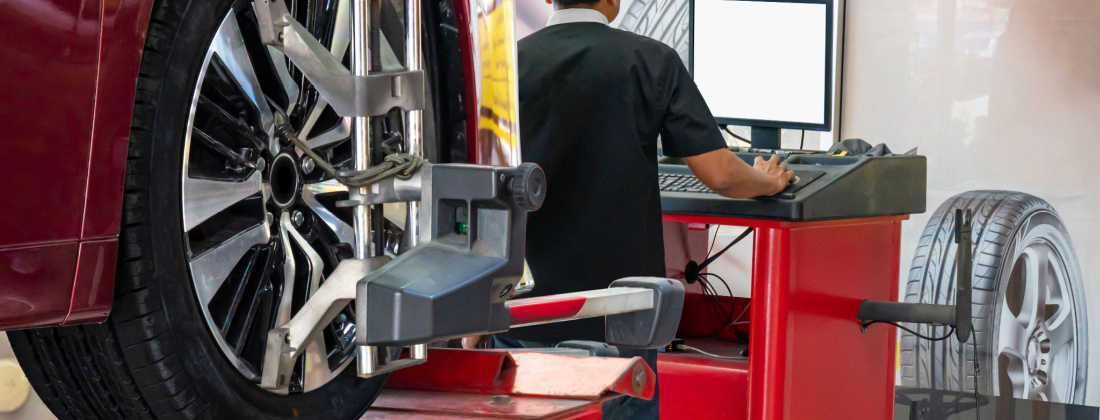
Wheel Alignment Services at Ward Tire
All About Wheel Alignment
Many people hear the words wheel alignment but are unsure what they actually mean. The true intent of a wheel alignment service is to align all wheel angles with the automobile manufacturer’s requirements. These changes are used to lessen tire wear and guarantee straight and true travel without “pushing” to one side of the road. As a result, your tires will last longer, and you can drive straight on the road.
Importance of Wheel Alignment
The handling qualities of a vehicle can affect its overall safety; therefore, wheel alignment is a crucial component of vehicle maintenance. In addition to improving safety and handling, maintaining proper alignment may also lengthen the life of your tires and prevent wear, giving you the best return on your investment while simultaneously increasing fuel efficiency.
Compared to cars with improper wheel alignment, optimal wheel alignment enhances vehicle control and steering while shortening braking distances.
It is imperative to maintain good wheel alignment to prevent a needless amount of wear on your brakes, steering, suspension, and tires. Accurate wheel alignment enhances handling performance, increases tire life, and optimizes driving stability.
Benefits of Wheel Alignment:
Fuel efficiency – A wheel alignment could help you conserve fuel and fill up less often.
Smoother ride – Your ride will be more comfortable and enjoyable when driving after a wheel alignment.
Improved steering – Proper wheel alignment means you can steer clear of those problems and maintain stable car control.
What Causes Misalignments in Wheels?
Wheel misalignment has three basic reasons. The hard impact or rapid jarring brought on by running into anything, such as a pothole, a curb, or being in a car accident, and worn parts from normal wear and tear.
Your wheel alignment might change due to worn-out or slack components like suspension springs. Regular service inspections are required since prevention is always better than treatment in this situation.
Finally, is the alteration of height. When the suspension hasn’t been adjusted to fit, that is. Suppose you change your vehicle’s height without simultaneously changing the suspension. In that case, your wheels are likely to be out of alignment since the automotive suspension is built to function at a specific height.
Alignment Symptoms That Lead to a Poor Wheel Alignment
- Uneven or irregular tire wear
- Wheels cannot readily return to their original position after a turn. The steering wheel is warped or rattles.
- Your tires are making a screeching sound.
Why Do Vehicles Need Proper Wheel Alignment?
There is a limited tolerance for a variance from one car to the next with any mass-produced product. To accommodate variations in suspension component wear over time, some adjustability is built into the suspension when the vehicle is constructed.
How Does Ward Tire Provide Wheel Alignment Services?
A wheel alignment involves numerous aspects that make your ride smooth. The professionals at Ward Tire perform wheel alignment in the following manner:
Inspecting Camber
When seeing a vehicle’s wheels from the front or rear, camber refers to the inward or outward tilt of the wheels. Positive camber is when the wheel leans out from the automobile, whereas negative camber is when the top of the wheel leans in towards the center of the car.
Most cars come with very little negative camber (less than 1.5 degrees) so that when a car “leans” into a bend, the outer wheel will be parallel to the ground, maximizing traction and safety.
Caster
From the side, the caster is classified as negative if the steering angle leans toward the front of the vehicle and positive if the angle leans toward the vehicle’s rear.
An out-of-spec caster can have a significant impact. A vehicle will “wander” if the caster is adjusted too far negatively, and it will be difficult to maintain a straight course. Conversely, if the caster is set too far, the steering will be heavy, and the steering wheel will jerk violently over bumps.
Toe
The difference between a set of wheels is completely parallel to the vehicle’s centerline and not the toe measurement. One may calculate the toe by measuring the distance between the front and back of the same tire. Toe-in or toe-out differences can be expressed as any difference and are quantified in degrees.
The toe is one of, if not the most crucial, vehicle handling and tire longevity measurements. The toe setting should ideally be at or nearly zero degrees for optimal tire longevity. The outside or inner edge of the tread will wear out the tires very quickly if there is too much toe in either direction. The team carefully measures the toe and other components to make sure the wheel is aligned properly.
Book Your Wheel Alignment Service at Ward Tire
If you are looking for a wheel alignment service for your personal vehicle, look no further than Ward Tire. We operate 17 locations across Alberta and Saskatchewan. Our teams are able to provide you with sound advice on how best to maintain your vehicle and what happens when a repair is necessary. Call and speak with a service advisor today or book your next appointment online.

